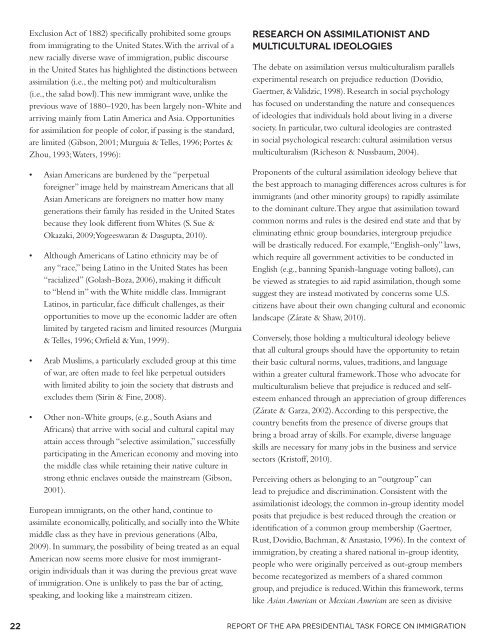Crossroads: The Psychology of Immigration in the New Century
Crossroads: The Psychology of Immigration in the New Century
Crossroads: The Psychology of Immigration in the New Century
Create successful ePaper yourself
Turn your PDF publications into a flip-book with our unique Google optimized e-Paper software.
Exclusion Act <strong>of</strong> 1882) specifically prohibited some groups<br />
from immigrat<strong>in</strong>g to <strong>the</strong> United States. With <strong>the</strong> arrival <strong>of</strong> a<br />
new racially diverse wave <strong>of</strong> immigration, public discourse<br />
<strong>in</strong> <strong>the</strong> United States has highlighted <strong>the</strong> dist<strong>in</strong>ctions between<br />
assimilation (i.e., <strong>the</strong> melt<strong>in</strong>g pot) and multiculturalism<br />
(i.e., <strong>the</strong> salad bowl). This new immigrant wave, unlike <strong>the</strong><br />
previous wave <strong>of</strong> 1880–1920, has been largely non-White and<br />
arriv<strong>in</strong>g ma<strong>in</strong>ly from Lat<strong>in</strong> America and Asia. Opportunities<br />
for assimilation for people <strong>of</strong> color, if pass<strong>in</strong>g is <strong>the</strong> standard,<br />
are limited (Gibson, 2001; Murguia & Telles, 1996; Portes &<br />
Zhou, 1993; Waters, 1996):<br />
• Asian Americans are burdened by <strong>the</strong> “perpetual<br />
foreigner” image held by ma<strong>in</strong>stream Americans that all<br />
Asian Americans are foreigners no matter how many<br />
generations <strong>the</strong>ir family has resided <strong>in</strong> <strong>the</strong> United States<br />
because <strong>the</strong>y look different from Whites (S. Sue &<br />
Okazaki, 2009; Yogeeswaran & Dasgupta, 2010).<br />
• Although Americans <strong>of</strong> Lat<strong>in</strong>o ethnicity may be <strong>of</strong><br />
any “race,” be<strong>in</strong>g Lat<strong>in</strong>o <strong>in</strong> <strong>the</strong> United States has been<br />
“racialized” (Golash-Boza, 2006), mak<strong>in</strong>g it difficult<br />
to “blend <strong>in</strong>” with <strong>the</strong> White middle class. Immigrant<br />
Lat<strong>in</strong>os, <strong>in</strong> particular, face difficult challenges, as <strong>the</strong>ir<br />
opportunities to move up <strong>the</strong> economic ladder are <strong>of</strong>ten<br />
limited by targeted racism and limited resources (Murguia<br />
& Telles, 1996; Orfield & Yun, 1999).<br />
• Arab Muslims, a particularly excluded group at this time<br />
<strong>of</strong> war, are <strong>of</strong>ten made to feel like perpetual outsiders<br />
with limited ability to jo<strong>in</strong> <strong>the</strong> society that distrusts and<br />
excludes <strong>the</strong>m (Sir<strong>in</strong> & F<strong>in</strong>e, 2008).<br />
• O<strong>the</strong>r non-White groups, (e.g., South Asians and<br />
Africans) that arrive with social and cultural capital may<br />
atta<strong>in</strong> access through “selective assimilation,” successfully<br />
participat<strong>in</strong>g <strong>in</strong> <strong>the</strong> American economy and mov<strong>in</strong>g <strong>in</strong>to<br />
<strong>the</strong> middle class while reta<strong>in</strong><strong>in</strong>g <strong>the</strong>ir native culture <strong>in</strong><br />
strong ethnic enclaves outside <strong>the</strong> ma<strong>in</strong>stream (Gibson,<br />
2001).<br />
European immigrants, on <strong>the</strong> o<strong>the</strong>r hand, cont<strong>in</strong>ue to<br />
assimilate economically, politically, and socially <strong>in</strong>to <strong>the</strong> White<br />
middle class as <strong>the</strong>y have <strong>in</strong> previous generations (Alba,<br />
2009). In summary, <strong>the</strong> possibility <strong>of</strong> be<strong>in</strong>g treated as an equal<br />
American now seems more elusive for most immigrantorig<strong>in</strong><br />
<strong>in</strong>dividuals than it was dur<strong>in</strong>g <strong>the</strong> previous great wave<br />
<strong>of</strong> immigration. One is unlikely to pass <strong>the</strong> bar <strong>of</strong> act<strong>in</strong>g,<br />
speak<strong>in</strong>g, and look<strong>in</strong>g like a ma<strong>in</strong>stream citizen.<br />
research on assimilationist and<br />
Multicultural Ideologies<br />
<strong>The</strong> debate on assimilation versus multiculturalism parallels<br />
experimental research on prejudice reduction (Dovidio,<br />
Gaertner, & Validzic, 1998). Research <strong>in</strong> social psychology<br />
has focused on understand<strong>in</strong>g <strong>the</strong> nature and consequences<br />
<strong>of</strong> ideologies that <strong>in</strong>dividuals hold about liv<strong>in</strong>g <strong>in</strong> a diverse<br />
society. In particular, two cultural ideologies are contrasted<br />
<strong>in</strong> social psychological research: cultural assimilation versus<br />
multiculturalism (Richeson & Nussbaum, 2004).<br />
Proponents <strong>of</strong> <strong>the</strong> cultural assimilation ideology believe that<br />
<strong>the</strong> best approach to manag<strong>in</strong>g differences across cultures is for<br />
immigrants (and o<strong>the</strong>r m<strong>in</strong>ority groups) to rapidly assimilate<br />
to <strong>the</strong> dom<strong>in</strong>ant culture. <strong>The</strong>y argue that assimilation toward<br />
common norms and rules is <strong>the</strong> desired end state and that by<br />
elim<strong>in</strong>at<strong>in</strong>g ethnic group boundaries, <strong>in</strong>tergroup prejudice<br />
will be drastically reduced. For example, “English-only” laws,<br />
which require all government activities to be conducted <strong>in</strong><br />
English (e.g., bann<strong>in</strong>g Spanish-language vot<strong>in</strong>g ballots), can<br />
be viewed as strategies to aid rapid assimilation, though some<br />
suggest <strong>the</strong>y are <strong>in</strong>stead motivated by concerns some U.S.<br />
citizens have about <strong>the</strong>ir own chang<strong>in</strong>g cultural and economic<br />
landscape (Zárate & Shaw, 2010).<br />
Conversely, those hold<strong>in</strong>g a multicultural ideology believe<br />
that all cultural groups should have <strong>the</strong> opportunity to reta<strong>in</strong><br />
<strong>the</strong>ir basic cultural norms, values, traditions, and language<br />
with<strong>in</strong> a greater cultural framework. Those who advocate for<br />
multiculturalism believe that prejudice is reduced and selfesteem<br />
enhanced through an appreciation <strong>of</strong> group differences<br />
(Zárate & Garza, 2002). Accord<strong>in</strong>g to this perspective, <strong>the</strong><br />
country benefits from <strong>the</strong> presence <strong>of</strong> diverse groups that<br />
br<strong>in</strong>g a broad array <strong>of</strong> skills. For example, diverse language<br />
skills are necessary for many jobs <strong>in</strong> <strong>the</strong> bus<strong>in</strong>ess and service<br />
sectors (Krist<strong>of</strong>f, 2010).<br />
Perceiv<strong>in</strong>g o<strong>the</strong>rs as belong<strong>in</strong>g to an “outgroup” can<br />
lead to prejudice and discrim<strong>in</strong>ation. Consistent with <strong>the</strong><br />
assimilationist ideology, <strong>the</strong> common <strong>in</strong>-group identity model<br />
posits that prejudice is best reduced through <strong>the</strong> creation or<br />
identification <strong>of</strong> a common group membership (Gaertner,<br />
Rust, Dovidio, Bachman, & Anastasio, 1996). In <strong>the</strong> context <strong>of</strong><br />
immigration, by creat<strong>in</strong>g a shared national <strong>in</strong>-group identity,<br />
people who were orig<strong>in</strong>ally perceived as out-group members<br />
become recategorized as members <strong>of</strong> a shared common<br />
group, and prejudice is reduced. With<strong>in</strong> this framework, terms<br />
like Asian American or Mexican American are seen as divisive<br />
22 Report <strong>of</strong> <strong>the</strong> APA Presidential Task Force on <strong>Immigration</strong>
















